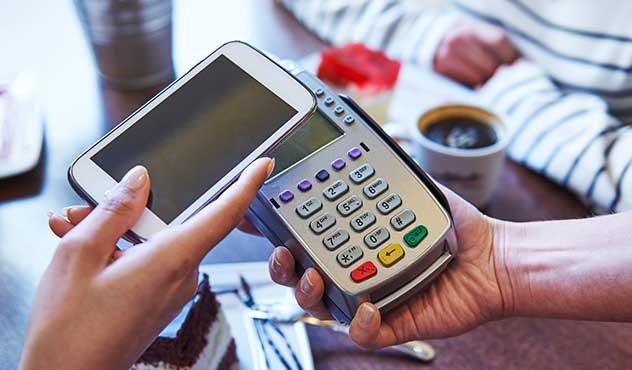Fintech Insights
Which credit card swiper is right for me?
August 04, 2019
Whether you’re starting a new business or upgrading your existing business technology, choosing the right credit card swiper, also known as a “terminal,” is an important decision to make. And while you may be an expert in your field, most small business owners are not experts when it comes to payment technology. Luckily, you don’t have to be. Read along to learn more about what considerations you should make when deciding which card swiper to use.
The basics
If you’re brand new to business ownership and have never worked with a payment processor, you’ll want to start here. If you’re somewhat experienced and have a general understanding of what is involved in taking credit cards, you can skip to the next section.
In order to accept credit and debit cards at your business, you must have a payment processing account, and a way of sending a customer’s payment card info to the processor for authorization. It's similar to having a telephone to make phone calls and a telephone network provider to make the connection. The phone itself has a host of features that work regardless of the network in use, like the camera and clock, and the network has its own features like area coverage and data plans.
Sometimes, the functionality of a credit card terminal is dependent on the services provided by the payment processor, and some payment processor capabilities are dependent on the payment terminal being used to swipe cards. To go back to the phone analogy, why pay more for a 4G phone when you’re only on a 3G network? The best combination for your business is one in which the terminal and the payment processing services are fully compatible.
Relationship matters
If you skipped the previous section, you’ll want to dive back in now to hear this: the optimal payments situation is one where your credit card terminal hardware is fully compatible with your payment processor. Which brings us to the cardinal rule of terminal shopping—never buy a terminal without choosing your payment processor first. Your terminal choice may severely limit your payment processing options and could even create a data security risk due to PCI security compliance concerns.
Even if you’re in the market for a fully customized point of sale (POS) system, it’s helpful to know what payment processors are compatible with that system and whether you’ll pay gateway or access fees to use the payment processor of your choice.
You may have a good idea of what type of terminal you want, and that can help you make a decision about which payment processor to go with. That’s great. Just don’t buy a terminal from an office supply store and then try to find a payment processor to work with it. You want to be confident about the kind of support you’ll be able to receive to help with setup and ongoing technical support.
Big feature buckets
Once you understand the relationship between terminals and payment processing, you can begin evaluating the terminals themselves.
Terminals come in three basic categories or buckets:
- Stand-alone terminals
- Mobile terminals
- Smart terminals
There are some functionality and feature cross overs between the categories, but by and large, the differences are substantial enough to warrant their own buckets.
Stand-alone terminals
The term “stand-alone” refers to the fact that this type of terminal is completely separate from other business management software programs. A stand-alone terminal typically plugs in via Ethernet cable, connects directly to the payment authorization network via the processor, and operates independently from the cash register or other types of POS systems.
Most stand-alone terminals perform the same basic functions. They send card data for authorization, transmit authorization codes or declines in response, and can perform other basic functions like tip adjustment, reversals, and voids. Many are capable of processing prepaid and gift card transactions as well, though you should ask about compatibility if you have a third-party gift solution.
In terms of functions and features, there isn’t a lot of differentiation within this category. Stand-alone terminals are likely to be hardy, and will likely outlive their usefulness in terms of technology and industry compliance before actually breaking down.
Stand-alone terminals are best suited for smaller businesses that aren’t interested in additional business management solutions like inventory management, accounting programs, data analytics, or employee management solutions. They typically don’t enable any sort of customer experience enhancements like loyalty programs or mobile acceptance.
Price points in this category are similar and range from around $150-300. Since the cost is relatively low, it’s probably best to buy this terminal outright, since long-term leasing may end up costing you more over the life of your payment processing account than the purchase price.
The simplicity, reliability, and affordability of stand-alone terminals can be enticing features to new business operators who are just getting started and don’t want a lot of overhead. Conversely, they’re also popular for smaller, well-established businesses that prefer a steady, no-frills business management style.
Shopping tip for stand-alone terminals: since the features and durability of stand-alone terminals are fairly standard across all brands, it’s more important to assess the reliability of the payment processing platform to ensure maximum uptime.
Mobile terminals
The concept of mobility when it comes to terminals can mean two separate things: 1. a basic terminal that has wireless connectivity and is transportable within the business; and 2. a small terminal device more commonly referred to as a “dongle” that plugs into a smartphone and can be used anywhere the phone is used.
Here is an example of a wireless terminal:

Here is an example of a payment dongle:

A transportable or payment terminal is often used in the restaurant setting as it enables servers to take payments tableside, instead of leaving the table with the customer’s card to process the transaction. Some retailers use them as a way of “line-busting,” which means checking customers out wherever they are in the store, rather than requiring them to stand in line at a checkout counter.
Transportable terminals are similar to stand-alone terminals in terms of functionality, with the exception of connecting to the authorization network via WiFi or 3G/4G networks. The connectivity options and distance they can be moved from the WiFi router varies by brand and could be a differentiator when comparing your options. Some POS systems have wireless PIN pads as an add-on option to enhance the stationary nature of traditional POS systems and can be purchased for $200 on the low end and $600 on the high end.
A mobile payment terminal that employs a dongle plug-in to capture a magnetic card swipe is a much simpler option. A popular version of dongle-based mobile terminals is the Square product, but there are many dongle devices on the market that will enable users to enjoy the convenience that the Square processing approach presents.
Unless you’re using a mobile dongle as an add-on feature for another terminal solution and processing relationship, you will also be limited in the types of functions you can perform. Some dongles come with apps capable of performing inventory and transaction history tracking, but in general, the business management capabilities of dongles leave much to be desired. The cost of these devices is usually minimal. Some processors sell them as add-ons for only $25-100.
Choose this option if your business is exclusively mobile. Mobile dongles tend to appeal to artisans, kiosks, service providers like massage therapists, and home-based businesses. If you operate a brick and mortar business and sometimes have a need to take a payment on the go, it’s likely to your advantage to explore options with reputable payment processors who can offer you a mobile dongle as an add-on to your main business terminal. Some offer Bluetooth connectivity which helps increase the speed of the transaction and offers a more streamlined and professional look since they don’t have to be physically connected to a mobile device.
Shopping tip for dongle-based terminals: Chip and signature EMV-enabled dongles are available on the market. Since you have liability for any fraudulent transactions that occur when you accept chip embedded cards, it’s a good idea to use EMV-friendly dongles.
Smart terminals
Smart terminals are relatively new on the terminal scene but hold a lot of promise for merchants of all sizes. They generally consist of a touch screen interface with app-based business management functions, a built-in credit card reader, and a scanner. Some even have dual screens, one for the customer, and one for the clerk.
A merchant looking to advance their business management capabilities and go beyond the most basic payment processing functions should strongly consider this option. It is the only type of terminal that also incorporates software programs like employee management tools, accounting, data analytics, inventory control, customer loyalty programs, and other back office tasks. Merchants are able to select the apps that best suit their needs from an app store, so the terminal is fully customizable.
It’s also the best choice for merchants looking to elevate the customer experience. The dual screen consumer display and wireless portability are just the tip of the iceberg with this terminal. It also has the ability to run fully-featured customer loyalty programs, delivering targeted offers and coupons to customers depending on their shopping behaviors. It enables customers to pay however they want, including EMV and contactless mobile payments.
Another reason merchants are turning toward smart terminals is their ability to grow and change with the business over time. By contrast, the capabilities of other terminals are static, meaning what you have on day one is what you’ll have on day 3,000. With a smart terminal, your business has the flexibility to evolve since it’s simple to change the apps in use as they become necessary or obsolete.
The price point on smart terminals is an increase over stand-alone and mobile options, averaging in the $600-1500 range. But in comparison to traditional POS solutions, which are the only other way to get close to this level of customization and scalability, they’re relatively affordable, and the added functionality easily offsets the cost. Plus, these terminals are often leased at affordable monthly rates, which is an attractive option for merchants intimidated by the price.
Shopping tip for smart terminals: Ask about which software applications are available with the terminal, and make sure they fit the needs of your business. Application flexibility is a perk worth paying for if you have plans to grow your business.
Which terminal is right for your business? There’s no wrong answer. It all depends on your needs, plans for the future, and your budget. If you’re still feeling unsure, ask your payment processor if they offer the flexibility to try a terminal and change your mind later.
Worldpay offers a variety of great terminals in every category. No matter what your needs are, we can find the perfect terminal fit for your business. Give us a call anytime if you’d like to discuss your options in greater depth.